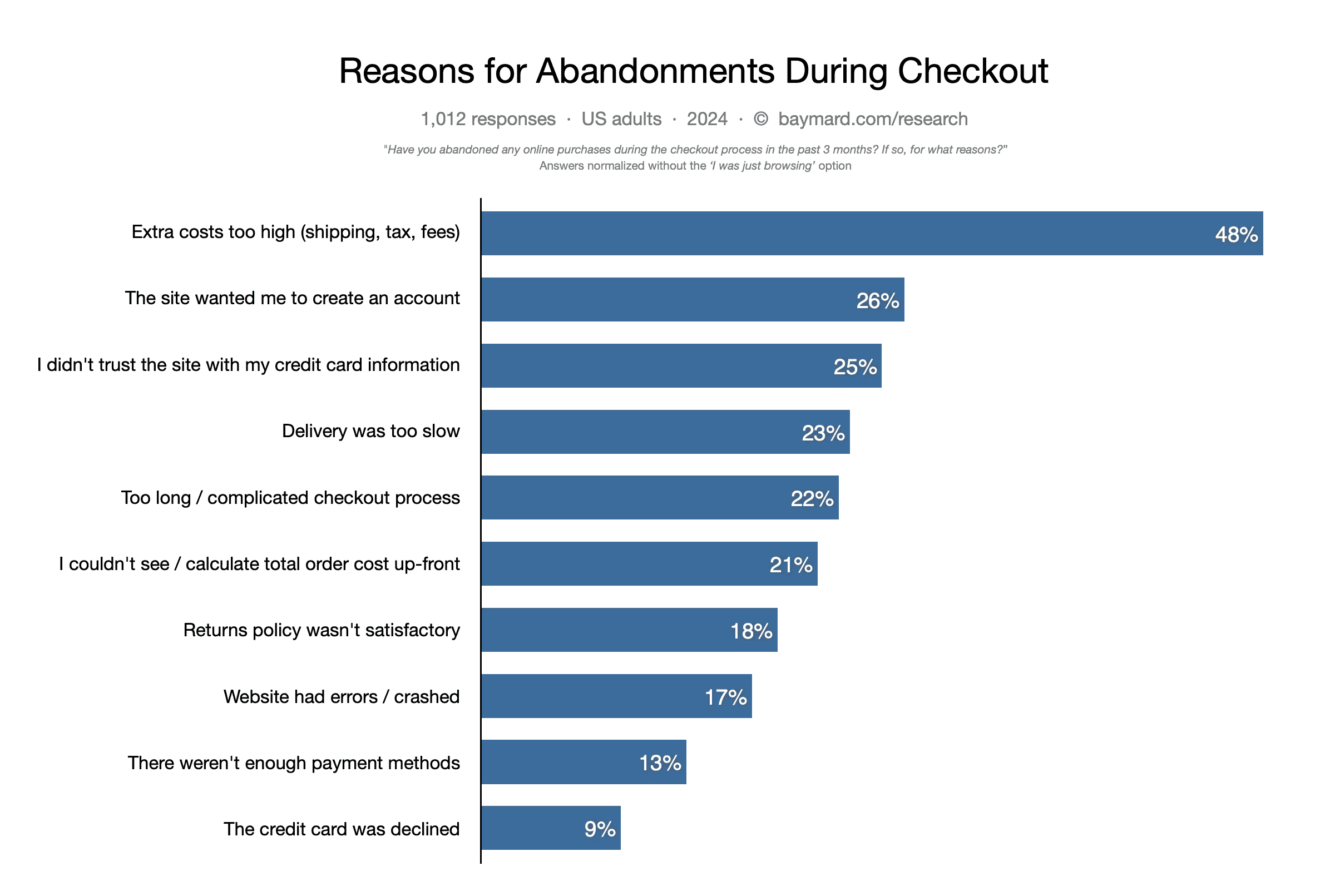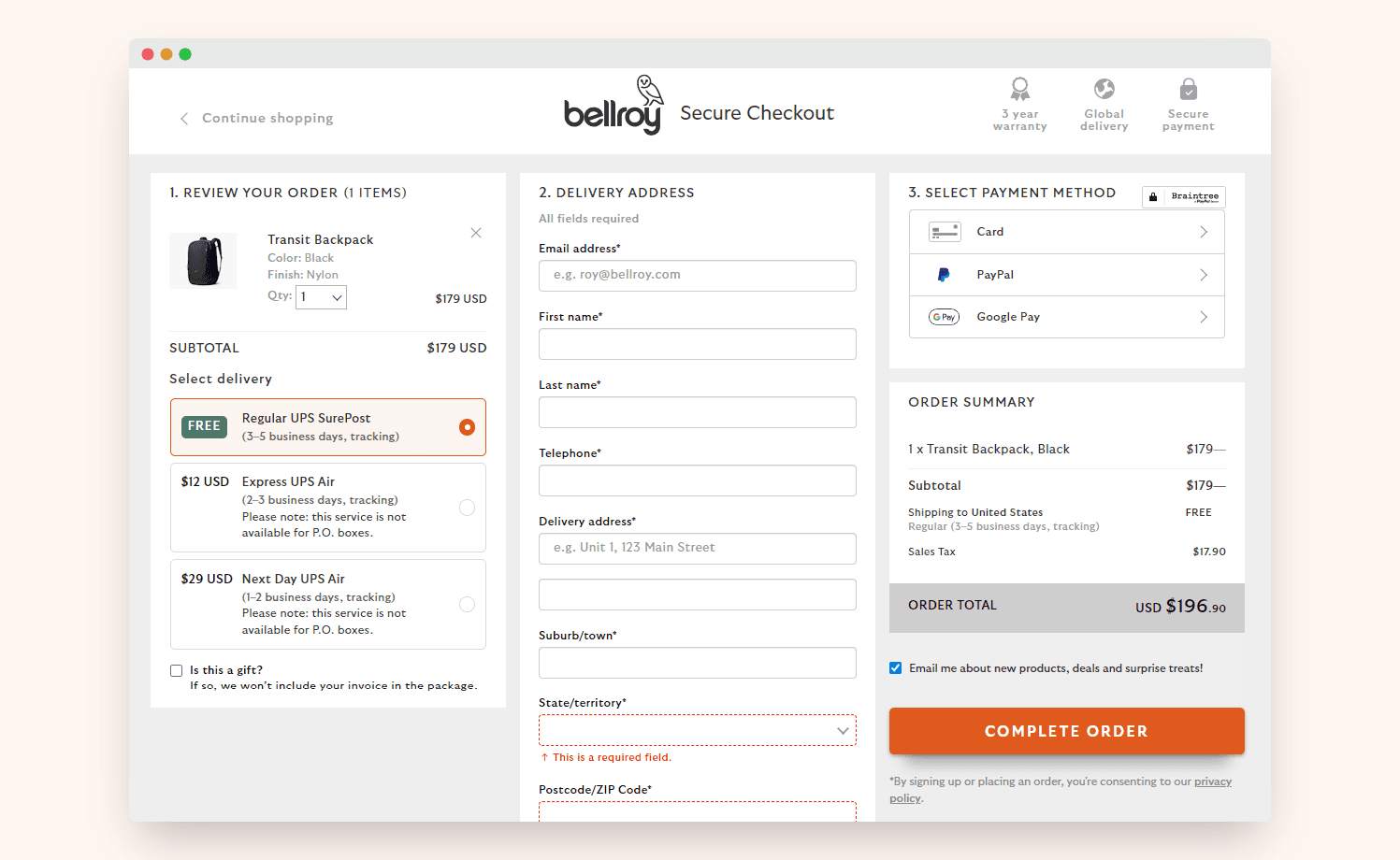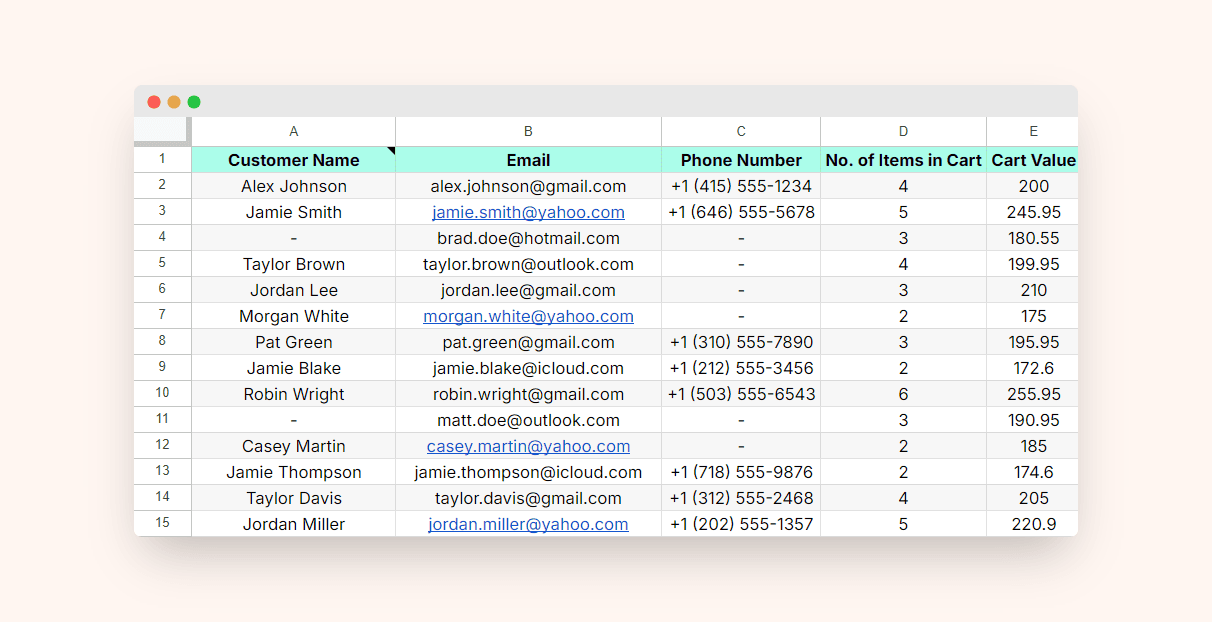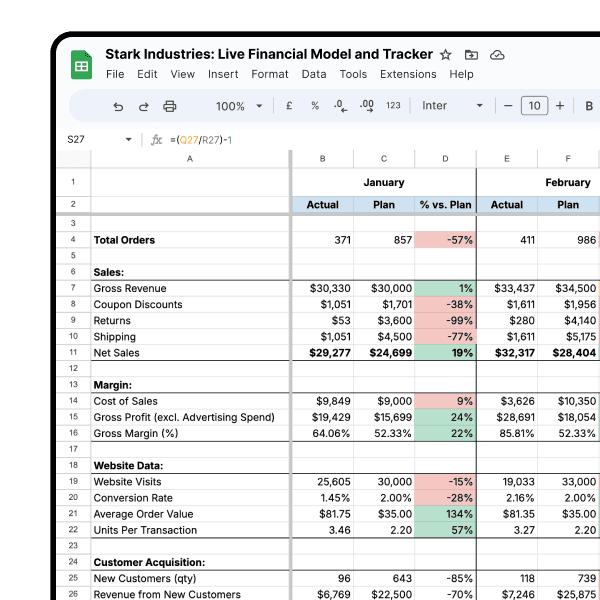Reporting and Analysis
27.09.2024
TLDR
To recover abandoned carts on Shopify, streamline the checkout process, offer transparent pricing, and provide multiple payment options to enhance the shopping experience. Implement timely follow-ups through targeted emails and retargeting campaigns, while leveraging analytics to understand abandonment reasons and optimize recovery strategies. Encouraging customer feedback and offering incentives can further improve conversion rates and maximize revenue.
Abandoned carts are a common challenge for Shopify store owners, often leading to significant revenue loss. When potential customers add items to their cart but leave without completing the purchase, it’s not just a missed sale—it’s a missed opportunity to understand and enhance the shopping experience. According to the Baymard Research Institute, the average cart abandonment rate is 70.14%, meaning 7 in every 10 shoppers in your store abandon their cart. You can significantly improve your checkout conversion rates and overall customer satisfaction by addressing the root causes of cart abandonment and implementing targeted recovery tactics.
What is Cart Abandonment?
Cart abandonment occurs when shoppers add products to their online cart but exit without completing the purchase. This phenomenon can significantly impact your Shopify store’s potential revenue. Baymard Research Institute identified some reasons why customers abandon their shopping carts:

Extra costs too high: Nearly half of the respondents, 48%, cited unexpected costs like shipping, tax, and fees as the main deterrent, highlighting the importance of transparency in pricing before checkout.
Site required account creation: A quarter of the shoppers, 26%, abandoned their carts because they were required to create an account, indicating a clear preference for a faster, guest checkout option.
Lack of trust with credit card information: 25% of respondents didn’t proceed with their purchase due to security concerns about providing credit card information, emphasizing the need for e-commerce sites to boost their security measures and trust signals.
Slow delivery: Slow delivery was a dealbreaker for 23% of respondents, suggesting that offering quicker shipping options could be crucial to retaining customer interest.
Complicated checkout process: 22% of shoppers walked away because they found the checkout process too long or complex, pointing to the need for a more streamlined and intuitive checkout experience. Checkout abandonment, a specific type of cart abandonment, often happens when customers are required to create an account during the checkout process, leading to frustration and exit.
Inability to see total order cost upfront: 21% were frustrated by not being able to see or calculate the total order cost upfront, stressing the need for clear and visible pricing throughout the shopping process.
Unsatisfactory returns policy: 18% were put off by an unsatisfactory returns policy, indicating that clear and favorable return policies are essential for encouraging purchases.
Website errors or crashes: Website stability issues caused 17% of potential buyers to abandon their carts, underlining the importance of a smoothly running e-commerce platform.
Insufficient payment methods: 13% of respondents left because the site didn’t offer enough payment options, showing that a variety of payment methods can help cater to different customer preferences and reduce cart abandonment.
Credit card declined: Lastly, 9% encountered issues with their credit card being declined, an interruption that can prevent a successful transaction and deter customers from trying again.
These insights suggest key areas for improvement that can help e-commerce businesses reduce cart abandonment and enhance overall customer satisfaction.
Effective Strategies to Reduce Shopify Cart Abandonment
To reduce Shopify cart abandonment, several strategies can be implemented that streamline the shopping experience and encourage customers to complete their purchases:
Streamline your Checkout Process
Simplifying the checkout experience is crucial. Reducing the number of steps required, offering guest checkout options, and clearly displaying progress indicators can help keep customers engaged and reduce frustration. Ensuring that the checkout page is intuitive and each step is clearly justified can minimize confusion and prevent abandonment. Also, providing real-time assistance through chatbots or customer service can help address any immediate queries or concerns during checkout. Bellroy implements this by using a one-page checkout.

Transparent Pricing
Clearly display all costs upfront, including taxes, shipping costs, and any additional charges, to prevent surprise costs at checkout. Consider incorporating a cost calculator or providing free shipping thresholds to enhance transparency and trust. This approach not only builds trust but also helps the customer feel in control of their purchasing decisions. Everlane’s checkout gives a clear breakdown of your order costs.

Offer Multiple Payment Options
Including a variety of payment methods can cater to different preferences and increase the likelihood of conversion. Expand options beyond traditional credit cards to include digital wallets like PayPal, Apple Pay, and others that provide quick and secure ways to pay. Periodically reviewing and adding new payment methods can keep your payment options relevant and accommodating for all customers. Ruggable accepts over 10 payment providers giving more options for shoppers.

Optimize for Mobile
With a significant volume of shopping done on mobile devices, it’s essential to ensure that your mobile site or app offers an optimized checkout experience. This includes making sure the site is responsive, loads quickly, and has big enough buttons for easy navigation on small screens. Also, testing regularly on various devices ensures all users have a smooth experience regardless of their device.
Improve Delivery Options
Fast delivery options can sway customers who are hesitant due to slow shipping times. Offer various shipping options to accommodate different needs and clearly communicate expected delivery times at the outset. Providing updates via email or SMS about the shipping process can further enhance customer satisfaction and reduce hesitancy. ColourPop Cosmetics offer multiple delivery options for shoppers.

Address Technical Issues
Regularly monitor and update your website to avoid crashes and errors that can lead to cart abandonment. Ensuring a smooth, bug-free user experience encourages customers to complete their purchases. Implementing a routine maintenance schedule for your website can prevent potential downtimes and preserve a seamless shopping experience.
Identifying Abandoned Carts on Shopify
Understanding and managing abandoned carts is crucial for improving conversion rates and overall sales performance. Here’s how you can identify abandoned shopping carts for your store:
Using Shopify
Shopify’s built-in features make it easy to track and analyze abandoned carts directly from your dashboard. Here’s how to access and use this feature:
Log into your Shopify admin panel
Navigate to the "Orders" section.
Select the "Abandoned Checkouts" link. This lists all carts that have items added but not purchased within a specific timeframe.

Using Airboxr
With Airboxr’s Abandoned Checkout by Customers Report, you can export details of abandoned checkouts on your store directly to your Google spreadsheet. It also enables you to quickly identify which carts have the most items and value enabling you to easily create segments of customers that you can easily import to your third-party apps for remarketing.

You can access the report through these steps:
Go to Airboxr’s Hop Marketplace.
Add Abandoned Checkout by Customers to your Hops.
Open a new sheet and run the Hop. Your data is ready!
Here’s how you can add and run the report using Airboxr’s side bar in your sheet:
Improve your DTC game. Sign up for weekly tips.
Effective Strategies to Recover Abandoned Carts
Abandoned cart recovery is essential for improving sales conversions and maximizing revenue. By implementing strategic actions and continuously refining your approach based on analytics, you can significantly enhance your recovery rates. Here’s how to effectively recover abandoned carts:
Timely Follow-Ups
Quick responses are key. Send an initial recovery email within an hour of abandonment to catch customers while their interest is still high. Follow up with additional reminders over the next few days if the cart remains abandoned, adjusting the frequency based on your typical customer response rates.
Segmentation
Tailor your recovery strategies by segmenting your customers based on their behavior and purchase history, especially when using Shopify abandoned cart emails. For example, first-time visitors might respond better to a discount offer, while repeat customers might appreciate a loyalty reward or personalized recommendation based on past purchases.
Retargeting Campaigns
Use retargeting ads to remind customers of the items they’ve left behind in their shopping cart. These ads can appear on various platforms and websites that your customers visit after leaving your site, keeping your products top of mind and encouraging a return visit.
Checkout Optimization
Continuously analyze and optimize your checkout process to remove any friction points. Use A/B testing to try different layouts, forms, and informational cues to determine what works best for reducing abandonment.
Incentives and Offers
Entice customers back to reduce shopping cart abandonment with offers tailored to their interests and cart contents. Exclusive discounts, limited-time promotions, and free shipping are effective incentives that can convert abandoned carts into sales. It is important to consider and analyze the financial burden of these offers carefully to understand how they will affect your store’s profit bottom line.
Use of Analytics
Integrating robust analytics is vital for tracking the success of your recovery strategies. Analyze data to understand the reasons behind cart abandonment and the effectiveness of your recovery tactics. Metrics such as cart abandonment rate and conversion rate from Shopify and/or Google Analytics paired with open rates, click-through rates, and conversion rates from recovery emails and ads will help you refine your approach.
Customer Feedback
Encourage feedback to understand better why customers are abandoning their carts in your online store. This information can provide valuable insights for improving both product offerings and the shopping experience.
By applying these strategies and leveraging analytics to guide and refine your efforts, you can create a more effective cart recovery process. Continuous improvement based on data-driven insights will help you tailor your approach to meet customer needs better and recover more sales effectively.


